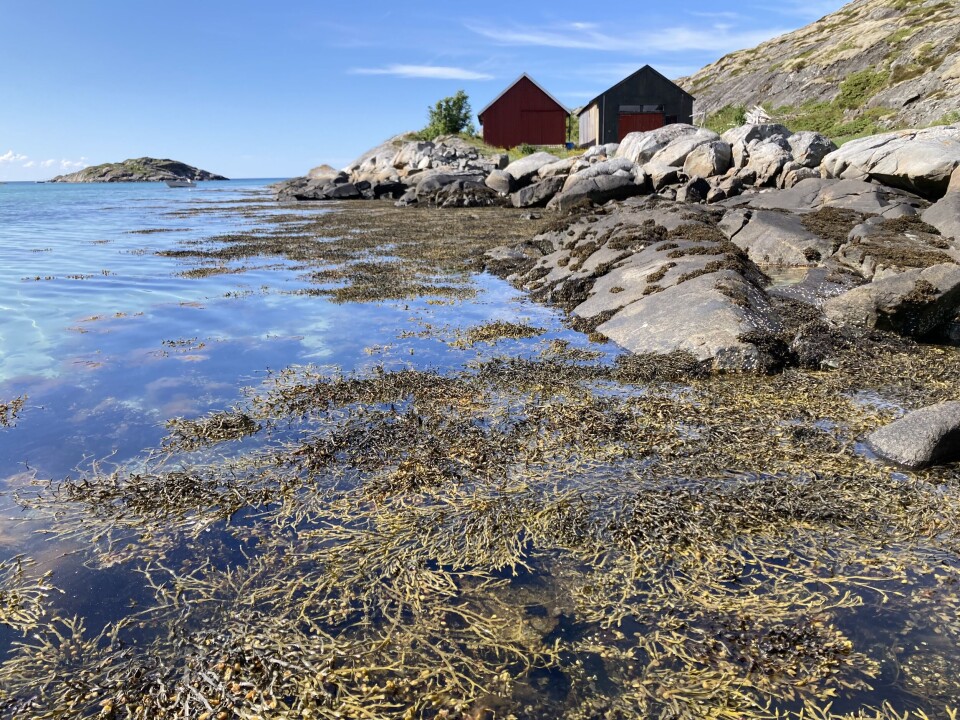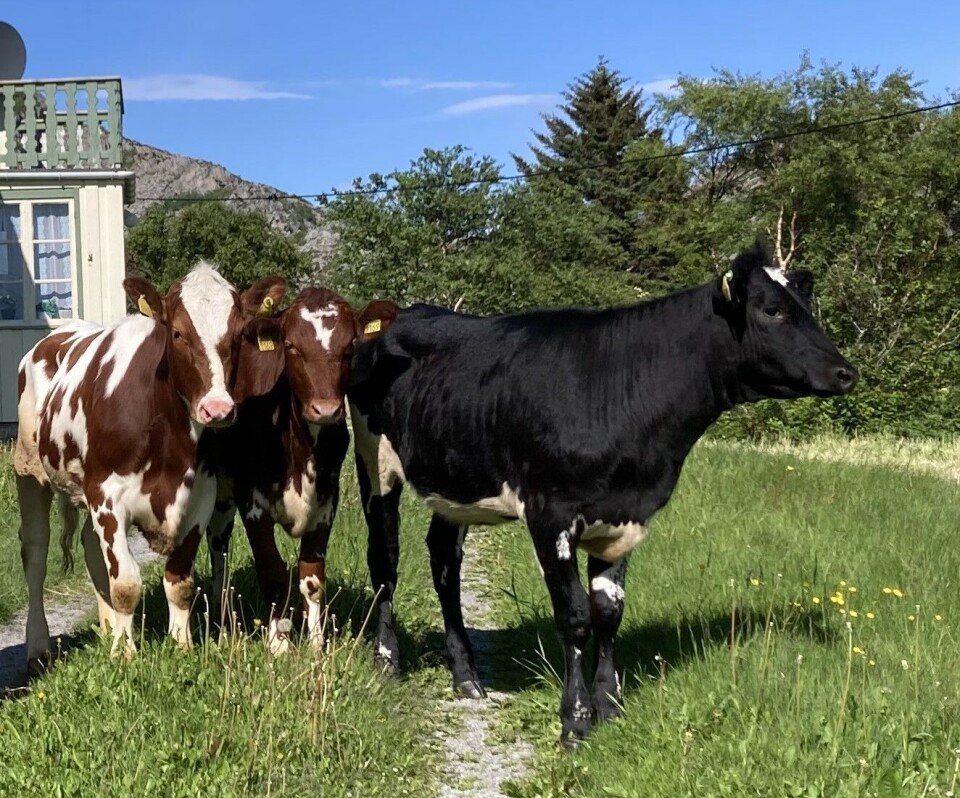THIS CONTENT IS BROUGHT TO YOU BY Nord University - read more

Bladderwrack in animal feed has the potential to reduce methane emissions
Researchers have managed to reduce methane emissions in ruminants by over 60 percent by adding bladderwrack to animal feed in laboratory experiments.
The results come from a study where researchers exposed a seaweed-feed mixture to digestive fluid from a cow's rumen.
Ruminants, such as cows, sheep, and goats, have a 4-chambered stomach, where the rumen is the biggest component. The rumen contains a unique set of microorganisms. These microorganisms play an important role in feed digestion, but some of them also produce methane gas.

Methane is a potent greenhouse gas that significantly contributes to global warming. Methane production from ruminants, therefore, has a negative impact on the environment.
As part of efforts to reduce greenhouse gas emissions, there has been a strong focus on finding alternative feed supplements that can be directly added to the diets of ruminants.
13 Norwegian species
Some marine macroalgae – seaweed and kelp – have already shown promising results. This is particularly true for the red tropical alga Asparogopsis. However, little is known about whether Nordic or Norwegian seaweed also have the potential to reduce methane production in ruminants.
A team of researchers from Norway and Denmark conducted a study to explore the potential of 13 Norwegian seaweed species as animal feed ingredients.
The researchers also examined how the nutritional content and the potential to reduce methane gas production in the rumen change throughout the seasons, or the seaweed's growth season.
“Macroalgae contain certain special substances, also called bioactive compounds, which help them survive and defend themselves in the harsh environmental conditions in the sea. These compounds can change the composition and activity of microorganisms living in the rumen of ruminants. This includes microorganisms that produces methane gas," says Deepak Pandey.
Pandey has studied marine macroalgae as an environmentally friendly and health-promoting ingredient in animal feed at Nord University.
Bladderwrack and knotted wrack
“By adding 20 per cent of the algae to the feed and fermenting it using rumen fluid from cow stomachs, we found that some of the macroalgae harvested from the Norwegian coast were able to reduce methane emissions," says Pandey.
One of the most important species, Fucus vesiculosus, reduced methane emissions by as much as 62 per cent.
This species is better known as bladderwrack. It grows in large quantities along the entire Norwegian coast. Another brown alga that can easily be confused with bladderwrack is knotted wrack (Ascophyllum nodosum).
This species also contributed significantly to reducing methane production in the feed experiments.

Unique polyphenols
Both these brown seaweed species have in common that they are rich in bioactive compounds, particularly polyphenols and phlorotannin. Polyphenols are substances in plants that protect against damage and diseases. Phlorotannin acts as a defence mechanism against environmental stresses and predators.
“These are substances that algae produce to defend themselves against adverse climatic conditions, such as exposure to sunlight. These substances have several beneficial properties for health and work as antimicrobials and antioxidants," says researcher Prabhat Khanal at Nord University.
The researchers found that a high polyphenol content was associated with the microalgae's ability to reduce methane production. They also found that the reduction in methane gas was associated with reduced digestibility.
A 20 per cent inclusion of bladderwrack and knotted wrack in the feed reduced digestibility in the trials by 25 per cent.
The climate benefit of macroalgae as a feed supplement may therefore come at the expense of digestibility and feed utilisation.
“Microorganisms help digest the food. But not all have such a useful role for the animal. Some microorganisms digest carbohydrates, while others only produce methane. What happened was that the methane-producing microorganisms were reduced, but the bacteria responsible for feed degradation were also affected,” says Pandey.
Which algae are beneficial?
The ideal situation would therefore be to find a feed supplement that only hinders the methane-producing microorganisms without compromising the bacteria responsible for digestion.
“The question then becomes: How much algae should be added to the feed? And which types? This depends not only on the methane reducing property of algae, but also on their nutritive values and effect on feed digestion,” the researcher says.
Certain other species, such as the green alga Ulva lactuca, also led to a significant reduction in methane production. In this case, the reduction was 30 per cent compared to the control diet without macroalgae. Unlike most brown macroalgae, the green alga has a high protein content.
“Even though the methane reduction is not as high as 60 per cent, it's an important finding. If we can reduce methane production by 'only' 30 per cent, it would still have a significant impact on greenhouse gas emissions," says Khanal.
An underutilised resource
Khanal emphasises that the economic aspect of using macroalgae in livestock production must also be considered.
“Seaweeds are underutilised and are good sources of nutrients and bioactive compounds. But the question is whether their commercial production is economically sustainable. Can it increase the profitability of farmers? This is something that must always be included in the calculations,” he says.
Researchers at Nord University have also compared the nutrient content of Norwegian brown algae at different times of the year.
Harvesting the algae in the spring results in a higher protein content than in the autumn. However, the polyphenol content is higher in the autumn than in the spring.
“This is important knowledge to have when harvesting the seaweed. One must choose the season based on what the seaweed will be used for,” he says.
Seaweed and kelp have been difficult to use as animal feed because they contain certain carbohydrates that are difficult to digest. Brown algae also have high levels of minerals such as iodine, phosphorus, and sodium. This can limit their use in animal feed.

Khanal explains that animals need a certain amount of minerals, but too high an intake can have negative effects. However, the mineral content in the algae can be reduced after harvesting with processes such as blanching in hot water.
“Such simple processing can increase their safety as animal feed. But again, we need to consider sustainability, both economically and environmentally,” he says.
In other words, more research is needed before we can take advantage of the environmental benefits of marine algae. At Nord University, Khanal and other researchers aim to develop new projects by taking the experiments out of the laboratory and into the barn.
“But first, we need to conduct more laboratory experiments. So far, we have harvested seaweeds in the spring and fall, but we also want to look at the summer season. Once we study the seaweeds from the three seasons in the laboratory, we can move on to large-scale feed experiments on animals,” says Khanal.
Reference:
Pandey et al. Interspecies and seasonal variations in macroalgae from the Nordic region: Chemical composition and impacts on rumen fermentation and microbiome assembly, Journal of Cleaner Production, vol. 363, 2022. DOI: 10.1016/j.jclepro.2022.132456

This content is paid for and presented by Nord University
This content is created by Nord University's communication staff, who use this platform to communicate science and share results from research with the public. Nord University is one of more than 80 owners of ScienceNorway.no. Read more here.
More content from Nord University:
-
Kateryna's university has been bombed three times – but she's still teaching
-
5 things you didn't know about smart cities in the Arctic
-
AI sparked an idea that could improve road safety in Norway
-
These algae have been adapting for hundreds of millions of years
-
Could traces of bacteria in water combat salmon disease?
-
Researchers unveil the genetic history of the great white shark




































